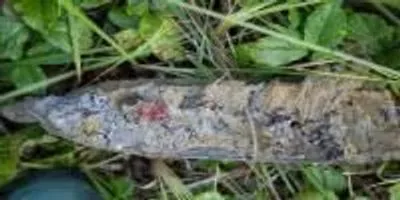 Soil from Millbrook Marsh, State College, PA. The blue/gray color below the soil surface indicates that this soil is usually very wet.Photo Courtesy of: M. Tiedeman
Soil from Millbrook Marsh, State College, PA. The blue/gray color below the soil surface indicates that this soil is usually very wet.Photo Courtesy of: M. Tiedeman
What is the first color that comes to mind when you envision soil? Is it brown, black, yellow, or red? How about white, gray, green, or blue? The Soil Science Society of America (SSSA) September 1 Soils Matter blog post explains that of these answers are correct depending on where you are from! It is true; soils come in an incredible range of colors.
According to soil scientist Mary Tiedeman, “Several forces influence soil color. Scientists document color when studying soils, as it clues them in to how soils may have formed. Color is also a good tool for determining the physical characteristics of soil.”
“The amount of organic matter—decomposed plant litter for example—and soil moisture affects soil color,” says Tiedeman. “So does the presence or absence of minerals. But, we could argue that climate is one of the most important.”
How then, does soil color differ across climatic zones?
1. Cold wet areas, like the tundra of Northern Canada and Siberia generally have black, dark brown, and gray colored soils.
2. Wetlands that are always soaked, don’t allow for soil microbes to get oxygen from the air. So gray, blue, or even green colored soils are common.
3. Desert soils can range from red, yellow/tan, to white.
4. Soils in tropical environments are known for their bright red, orange, and brown colors.
To read the entire blog post, visit https://soilsmatter.wordpress.com/2016/09/01/in-general-what-relationship-does-soil-color-bear-to-climate/
Follow SSSA on Facebook at https://www.facebook.com/SSSA.soils, Twitter at SSSA_Soils. SSSA has soils information onwww.soils.org/discover-soils, for teachers at www.soils4teachers.org, and for students through 12th grade,www.soils4kids.org.
The Soil Science Society of America (SSSA) is a progressive international scientific society that fosters the transfer of knowledge and practices to sustain global soils. Based in Madison, WI, and founded in 1936, SSSA is the professional home for 6,000+ members and 1,000+ certified professionals dedicated to advancing the field of soil science. The Society provides information about soils in relation to crop production, environmental quality, ecosystem sustainability, bioremediation, waste management, recycling, and wise land use.











